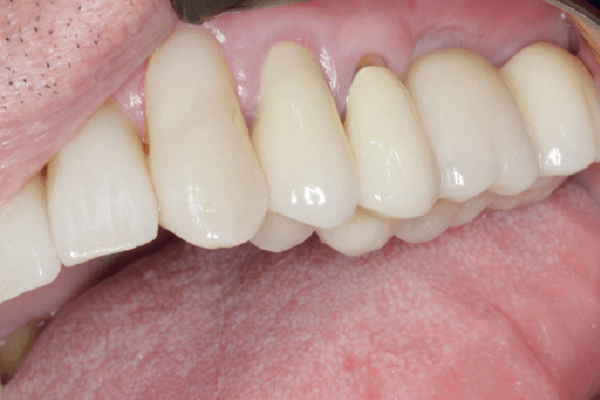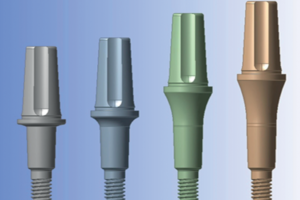RESUMO
O objetivo desta série de casos foi discutir as vantagens da técnica de osseodensificação para levantamento de assoalho do seio maxilar na reabilitação de maxila posterior com pouco remanescente ósseo. Quatro pacientes adultos sem comorbidades declaradas necessitaram de reabilitação do dente 26. Os exames de tomografia computadorizada de feixe cônico (TCFC) mostraram necessidade de aumento vertical ósseo para reabilitação com implantes osseointegrados. A técnica sugerida foi a osseodensificação com instalação imediata de implante. As cirurgias foram realizadas conforme preconizado pelo fabricante de brocas, com instalação imediata de implantes e cicatrização submersa. Após seis meses de instalação, os implantes foram expostos e próteses foram confeccionadas e instaladas. A média de ganho ósseo obtido foi de 7 mm. Os pacientes não experimentaram hemorragia nasal/bucal, dor extenuante, dor de cabeça ou qualquer outro evento mórbido relacionado ao procedimento. Ao final de até dois anos de acompanhamento, foi observado 100% de sobrevivência dos implantes e próteses com a técnica empregada. Os achados clínicos sugerem que a técnica de osseodensificação para instalação de implantes em maxila posterior atrófica foi bem-sucedida porque, além da alta taxa de sobrevivência dos implantes/próteses, colaborando para o aumento no grau de satisfação dos pacientes, também não foram observadas intercorrências negativas no transcirúrgico e no pós-operatório.
Palavras-chave – Implantes dentários; Osseodensificação; Elevação atraumática do assoalho do seio maxilar; Série de casos.
ABSTRACT
The aim of this case series was to discuss the advantages of the osseodensification technique for lifting the maxillary sinus floor in the rehabilitation of the posterior maxilla with few remaining bone. Four adult patients, with no declared co-morbidities, required rehabilitation of tooth 26. Cone-beam computed tomography (CBCT) examination showed the need for vertical bone augmentation for rehabilitation with osseointegrated implants. The suggested technique was osseodensification with immediate implant placement. The surgeries were performed as recommended by the drill manufacturer, with immediate implants installation, in a submerged healing. After 6 months of installation, the implants were exposed, prostheses were made and installed. The mean bone gain obtained was 7 mm. Patients did not experience nose/mouth bleeding, excruciating pain, headache, or any other morbid event related to the procedure. At the end of up to 2 years of follow-up, 100% survival of implants and prostheses was observed with the technique employed. The clinical findings suggest that the osseodensification technique for installing implants in the atrophic posterior maxilla was successful because, in addition to the high survival rate of the implants/prostheses, contributing to the increase in the degree of patient satisfaction, no negative intercurrences were observed in the during surgery or after surgery.
Key words – Dental implants; Osseodensification; Atraumatic sinus lift; Case series.
Referências
- Katsuyama H, Jensen SS. ITI Treatment guide (volume 5). Sinus floor elevation procedures. Eds. Chen S, Buser D, Wismeijer D. Berlim: Quintessence Publishing. p.214.
- Valcanaia TDC, Valcanaia A, Sukekava F. Abordagem transcrestal para levantamento do assoalho do seio maxilar com utilização de pontas cirúrgicas tipo copo. Série de casos. ImplantNews 2022;7(6):862-8.
- Luiz J, Luiz JH, Jarry CR, Sukekava F. Implantes ancorados na tuberosidade maxilar com carga imediata. Full Dent Sci 2022;13(50):24-31.
- Lazarov A. A prospective cohort study of maxillary sinus complications in relation to treatments with strategic implants penetrating into the sinus. Ann Maxillofac Surg 2020;10(2):365-9.
- Huwais S, Meyer EG. A novel osseous densification approach in implant osteotomy preparation to increase biomechanical primary stability, bone mineral density, and bone-to-implant contact. Int J Oral Maxillofac Implants 2017;32(1):27-36.
- Bhalla N, Dym H. Update on maxillary sinus augmentation. Dent Clin North Am 2021;65(1):197-210.
- Luiz J, Luiz JH, Sukekava F. Experiência de uso e curva de aprendizado com uma nova superfície/desenho de implante dentário para carga imediata: estudo preliminar. ImplantNews Reab Oral 2020;5(4):562-71.
- Berglundh T, Armitage G, Araujo MG, Avila-Ortiz G, Blanco J, Camargo PM et al. Peri-implant diseases and conditions: consensus report of workgroup 4 of the 2017 World Workshop on the Classification of Periodontal and Peri-Implant Diseases and Conditions. J Clin Periodontol 2018;45(suppl.20):S286-S291.
- Pjetursson BE, Rast C, Brägger U, Schmidlin K, Zwahlen M, Lang NP. Maxillary sinus floor elevation using the (transalveolar) osteotome technique with or without grafting material. Part I: implant survival and patients’ perception. Clin Oral Implants Res 2009;20(7):667-76.
- Moraschini V, Uzeda MG, Sartoretto SC, Calasans-Maia MD. Maxillary sinus floor elevation with simultaneous implant placement without grafting materials: a systematic review and meta-analysis. Int J Oral Maxillofac Surg 2017;46(5):636-47.
- Rodda A, Koduganti RR, Manne HK, Gullapelli P, Devarampati LJ. Implant placement post maxillary sinus lift using osseodensification concept: a case report. Cureus 2022;14(1):e21756.
- Jensen SS, Terheyden H. Bone augmentation procedures in localized defects in the alveolar ridge: clinical results with different bone grafts and bone substitutes materials. Int J Oral Maxillofac Implants 2009;24(suppl.):218-36.
- Cucchi A, Vignudelli E, Napolitano A, Marchetti C, Corinaldesi G. Evaluation of complication rates and vertical bone gain after guided bone regeneration with non-resorbable membranes versus titanium meshes and resorbable membranes. A randomized clinical trial. Clin Implant Dent Relat Res 2017;19(5):821-32.
- Farina R, Simonelli A, Franceschetti G, Travaglini D, Consolo U, Minenna L et al. Implant-supported rehabilitation following transcrestal and lateral sinus floor elevation: analysis of costs and quality of life from a bicenter, parallel-arm randomized trial. Minerva Dent Oral Sci 2022;71(1):16-24.





